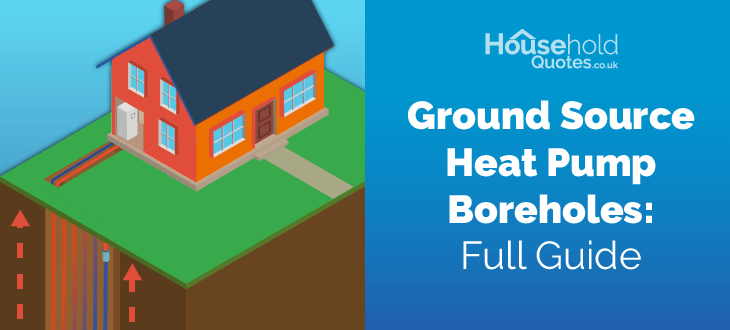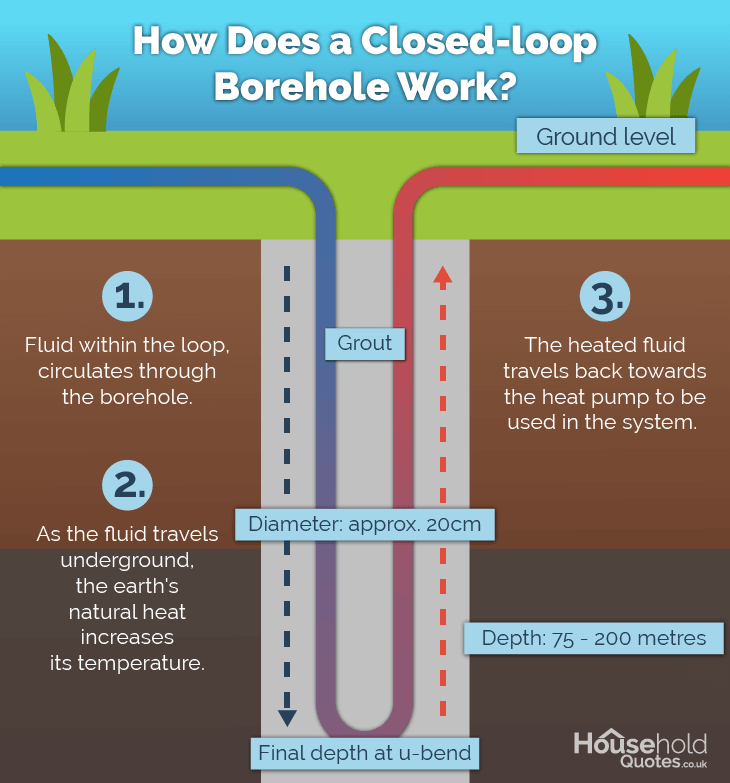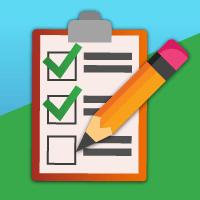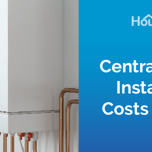Answer these simple questions and we will find you the BEST prices
Which type of solar quotes do you need?
It only takes 30 seconds
100% free with no obligation

Get up to 4 quotes by filling in only 1 quick form

Install a heat pump for less with the BUS grant

Increase the value of your home by installing a heat pump
- Householdquotes.co.uk
- Heat Pumps
- Ground Source
- Ground Source Heat Pump Borehole
Ground Source Heat Pump Borehole: Process, Costs & Depth


- A borehole is a narrow, deep well drilled into the earth. It transfers the constant temperature of the ground to your home heating system via a ground source heat pump.
- The cost for an average of 1-3 boreholes typically ranges from £10,000 to £30,000.
- The depth of a ground source heat pump borehole is between 75 - 200 metres. Deeper boreholes can provide better heat exchange but can be more expensive.
Ready to ditch fossil fuels and heat your home with the Earth's natural warmth? then a ground source heat pump could be for you. These systems can heat and cool your home simply using the earth’s natural underground warmth. For many people, using boreholes with this system is the best and most practical choice - but what exactly are boreholes?
The narrow holes are dug deep down into the ground to reach the natural heat of the earth below. This heat can then be transferred to your property, offering a completely renewable heating system that can save you up to £1,300 per year and reduce your carbon footprint by up to 12,000kg.
In this article, we’ll explore the installation process, costs, and depth considerations of ground source heat pump boreholes, helping you decide if this technology might be a good fit for your home. Read our comprehensive guide to learn everything you need to know about boreholes!
If you’re ready to install a ground source heat pump but are unsure where to begin - we can help! We understand the stress it can cause trying to find trustworthy installers and quotes from here, there and everywhere - that’s why we’ve created a simple solution.
By filling in our simple online form, we can connect you with up to 4 vetted installers from your area. They can provide you with free, no-obligation quotes for you to compare, so you can be sure you get the best deal and a top-class service (without the stress).
To get your free quotes, just click the button below to get started.
- Quotes from local installers
- Payment by finance available
- Save £7,500 with BUS grant
It only takes 30 seconds

- What is a ground source heat pump borehole?
- Ground source heat pump borehole cost
- The process of making a borehole for heat pumps
- Ground source heat pump borehole depth
- What to consider before installing a ground source borehole?
- Is a ground source heat pump with a borehole the right choice for my household?
- FAQ
What is a ground source heat pump borehole?
A ground source heat pump borehole is a narrow, vertical hole drilled deep into the ground. The diameter of a typical borehole is quite small, usually around 20cm. The depth of these boreholes can vary depending on factors like ground conditions and your heating/cooling needs, but they can be between 75 to 200 metres.
These vertical boreholes act as an underground heat exchanger for your ground source heat pump system. Unlike horizontal ground loops, which utilise a network of pipes buried in trenches, boreholes take advantage of the constant, reliable temperature present deeper within the ground.
Once drilled, a closed-loop system of pipes filled with a heat transfer fluid is inserted into the borehole. This fluid circulates, absorbing heat from the ground in winter and transferring it to your home's heating system. In summer, the process can be reversed, with the fluid absorbing heat from your home and releasing it back into the ground.

Ground source heat pump borehole cost
Ground source heat pump boreholes are a significant investment, but their efficiency and longevity can lead to substantial savings on your energy bills over time. Depending on the size and heat requirements of your home, boreholes can cost between £10,000 - £30,000.
Installing a ground source heat pump will require several individual components, which will impact the total cost. Below, we have outlined an estimate of the prices you might expect.
| Ground Source Heat Pumps Costs | |
|---|---|
| Element | Price Estimate |
| Ground source heat pump | £13,200 - £19,000 |
| Boreholes (Average 1-3 holes) | £10,000 - £30,000 |
| Pipework | £2,000 - £4,000 |
| Total estimated cost | £25,200 - £53,000 |
The cost of a ground source heat pump with boreholes can be impacted by multiple factors, including:
Cost per metre
Drilling a borehole typically costs between £25 - £40 per square metre. However, this is just a starting point, as additional work, such as grouting, can increase the cost. Actual costs can also vary depending on your location and specific ground conditions.
Number of boreholes
The size and heating demand of your home will determine how many boreholes are needed. A larger property with higher energy demands might require multiple boreholes, increasing the overall cost.
One way to estimate the number of boreholes you need is to allocate 1 borehole per 6kW of power you require. Below, we have outlined some of the average costs and the number of boreholes required depending on the heat pump size.
| Average Installation Costs per Ground Source Heat Pump Size | |||
|---|---|---|---|
| Home Size | Heat Pump Size | Number of Boreholes | Estimated Total Cost (Heat pump, boreholes, pipework) |
| Small 1-2 Bedrooms | 8kW | 1 - 2 | £25,200 - £27,200 |
| Medium 2-3 Bedrooms | 12kW | 2 | £36,850 - £38,850 |
| Large 4+ Bedrooms | 16kW | 2 - 3 | £51,000 - £53,000 |
Depth and ground conditions
The depth required is also a major factor; deeper boreholes generally cost more. The number of boreholes needed for your home's heating and cooling demands also impacts the total cost. Additionally, the complexity of drilling can be influenced by the type of ground you have. Rockier terrain may require specialised equipment, adding to the cost.
Ground source heat pump grants
The good news is that there are financial incentives available to help offset the upfront cost of ground source heat pumps and their boreholes. For example, the Boiler Upgrade Scheme offers grants of up to £7,500 for installing heat pumps in the UK, including ground source models.
If you want to take advantage of the latest government incentives and save money on a ground source heat pump, we can help. It can be overwhelming to find quotes for a new heating system, and it can take hours of research to read reviews and request quotes - but it doesn’t have to be that way!
Using our quick and easy form, we can help you connect with professional, highly trusted installers from your area. They can offer you up to 4 free, no-obligation quotes to compare so that you can get the best deal for your budget.
Click the button below to get your free quotes and start your heat pump journey today!
- Quotes from local installers
- Payment by finance available
- Save £7,500 with BUS grant
It only takes 30 seconds

The process of making a borehole for heat pumps
Creating a borehole for your ground source heat pump is a specialised process, but understanding the steps involved can give you a good idea of what to expect. Here's a breakdown of the key stages:
1. Pre-installation considerations:

- Site assessment: A qualified installer will first assess your property to understand the ground conditions. This helps determine the optimal location and depth for the borehole(s). Local permits may also be required so the installer can guide you through that process.
- Choosing an installer: Look for a reputable installer accredited by a recognised body like the UK Ground Source Heat Pump Association (GSHPA). They will have the expertise and experience for safe and efficient borehole installation.
2. Drilling the borehole(s):

- Drilling rig: A specialised drilling rig arrives on-site and begins drilling vertically into the ground. The drilling process is precise and minimises disruption to your property.
- Depth: The depth of the borehole will depend on your specific needs and the ground conditions. Deeper boreholes generally offer better heat exchange but come at a higher cost. Your installer will perform a ground loop design to determine the optimal depth for your situation.
3. Loop installation:
- Closed-loop system: Once drilling is complete, a closed-loop system of pipes is inserted into the borehole. These pipes are typically made of durable polyethylene (PE) material.

- Heat transfer fluid: A special heat transfer fluid circulates within the closed loop, absorbing heat from the ground and transferring it to the ground source heat pump unit.
- Grouting the borehole: To ensure stability and efficient heat transfer, the space around the pipes is filled with a special grouting material. This grouting material acts as a thermal conductor, maximising heat exchange between the ground and the fluid.
4. Completion:
- Once the grouting cures, the borehole is complete and ready to connect to your GSHP system. A qualified engineer will handle this step, ensuring the entire system functions optimally for efficient and sustainable heating and cooling of your home.
5. Final checks:

-
The final step is to run a series of tests to ensure optimal performance. These include checking:
-
Borehole integrity: Pressure testing is done to ensure the borehole is properly sealed and has no leaks. This prevents contamination of groundwater and ensures the borehole's longevity.
-
Depth and diameter verification: Measurements are taken to confirm the borehole reaches the desired depth and maintains the correct diameter throughout. This ensures optimal heat exchange efficiency for the heat pump.
-
Grout inspection: If grouting was used to fill any gaps between the borehole wall and the ground formation, its quality and consistency are inspected. Proper grouting prevents ground movement and protects the borehole from contamination.
-
Water quality testing: Depending on the local regulations and water table conditions, a water sample might be taken to assess its quality. This is important for determining if additional water treatment is needed for the heat pump system.
-
Flow rate testing: A pump test might be conducted to verify the water flow rate within the borehole. This helps determine the efficiency of heat exchange for the chosen heat pump system.
- Final inspection: The borehole head and surrounding area are visually inspected to ensure everything is properly capped, sealed, and tidy. This includes checking for any potential hazards or damage.
Ground source heat pump borehole depth
Ground source heat pump boreholes typically range from 75 metres to 200 metres deep. This range reflects a balance between efficiency and cost. As the Earth’s temperature becomes more consistent, the further below the surface you go, the better the heat exchange efficiency can potentially be.
However, it's important to remember that drilling deeper can require more time, specialised equipment, and potentially additional permits, depending on local regulations. All of this can translate into higher costs.
The optimal depth for your boreholes will depend on factors specific to your property, such as ground conditions, heating needs, and budget. A qualified installer will help you find the perfect balance between efficiency and cost for your situation.
What to consider before installing a ground source borehole?
If you’re thinking about switching to a ground source heat pump with a borehole system, there are some key considerations to keep in mind before getting started.

-
Property suitability
Ground source boreholes are a space-saving solution, when compared to horizontal trenches, but they still require drilling access. Ensure your property has enough space for drilling rigs or necessary equipment to gain access.
-
Ground conditions
The thermal conductivity of your soil or rock will impact the efficiency of your borehole. A qualified installer can assess your ground conditions to determine if a borehole system is suitable and, if so, the optimal depth.
-
Heating and cooling needs
Consider your home's size and insulation, as well as your climate. Higher heating or cooling demands might require deeper boreholes or potentially even multiple boreholes.
-
Cost and financial incentives
Ground source boreholes are an investment, but financial incentives, such as government grants or local rebates, might help offset the cost. Research available grants in your area.
-
Choose a qualified installer
Find a reputable installer with experience in borehole installations. For peace of mind, look for accredited installers in your area.
-
Permits and regulations
Depending on your location, you may need to request a permit from The Environment Agency before you can install a ground source heat pump. For many cases, ground source heat pumps installed after October 2023 will not need an environmental permit. This is because they meet environmental requirements, such as: - Pipework and boreholes are fully sealed
- They do not take water from the environment
- They do not discharge water or fluids into the environment
Visit the UK government website to find the full regulations and exemption criteria for England, Northern Ireland, and Scotland.
-
Alternatives
If your property has limited outdoor space or you're on a tighter budget, explore potential alternatives. Air source heat pump prices are generally lower than a ground source heat pump, with the benefit of saving space - however, their efficiency levels tend to be lower.
Is a ground source heat pump with a borehole the right choice for my household?
If you’re looking for a highly efficient, environmentally friendly solution to heat and cool your home, then a ground source heat pump with boreholes is a great choice! Their use of a renewable heat source from the earth can not only shrink your energy bills but also your carbon footprint.
There are some considerations to keep in mind, however, such as your ground conditions, property access, and local regulations. However, this can all be handled and supported by seeking the help and expertise of a qualified ground source heat pump installer.
We know it can be overwhelming searching for people you can trust, obtaining quotes and reading endless online reviews. That’s why we’ve created the perfect solution! Avoid the hassle of scrolling through numerous websites and getting bogged down in emails - instead, fill in 1 quick and easy form.
With a few details, we can connect you with up to 4 installers in your area - each one trusted, qualified and thoroughly vetted by Household Quotes. They can offer you free, no-obligation quotes so you can compare prices and get the best deal.
Simply click the button below to get started.
- Quotes from local installers
- Payment by finance available
- Save £7,500 with BUS grant
It only takes 30 seconds

FAQ
The ideal depth for a ground source heat pump borehole is between 75 to 200 metres. This allows access to more stable, consistent ground temperatures.
The cost of drilling boreholes is typically between £10,000 – £30,000 for 1-3 holes. This figure can vary depending on the size of your home and how many holes you require. Additional costs should also be considered for installation fees and pipework.
On average, 1 – 3 boreholes can provide enough heat for most homes. The planning process of drilling boreholes can determine what you need. Very large properties may require more, but in most cases, drilling deeper can account for higher heating demand.
Ground source boreholes are a better choice for properties with limited outdoor space, but trenches may be more suitable for those with large available land and lower budgets. Seek the help of a qualified installer to make the best choice.
In most cases, you do not need special permission to install a ground source heat pump borehole in the UK. However, when considering your needs and circumstances, it is always advisable to consult your local authority to ensure compliance with any regulations and requirements.

Becky has been bringing quality advice to homeowners since 2021. As an experienced writer, she is keen to help our customers find the help they need when they need it.
- Ground Source Heat Pump Borehole: Process, Costs & Depth
- What is a ground source heat pump borehole?
- Ground source heat pump borehole cost
- The process of making a borehole for heat pumps
- Ground source heat pump borehole depth
- What to consider before installing a ground source borehole?
- Is a ground source heat pump with a borehole the right choice for my household?
- FAQ




